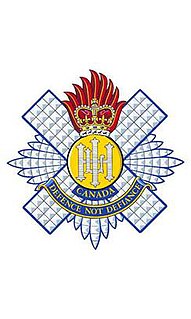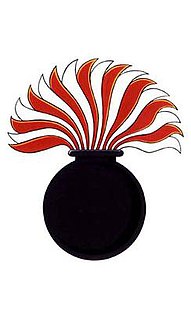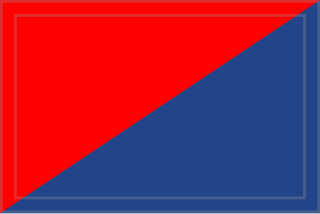
The Royal New Brunswick Regiment (RNBR) is a reserve infantry regiment of the Canadian Army based in New Brunswick. The Royal New Brunswick Regiment is part of 37 Canadian Brigade Group, 5th Canadian Division. The RNBR holds 65 battle honours.

The Royal Highland Fusiliers of Canada is a Primary Reserve light infantry regiment of the Canadian Army, with companies in Cambridge and Kitchener, and is an infantry sub-unit of 31 Canadian Brigade Group, headquartered in London, Ontario. The Princess Margaret, Countess of Snowdon and The Prince Andrew, Duke of York, as members of the Canadian Royal Family, acted as Colonel-in-Chief

The Lorne Scots is a Primary Reserve infantry regiment of the Canadian Army. It is part of the 4th Canadian Division's 32 Canadian Brigade Group.

The Winnipeg Grenadiers was an infantry regiment of the Canadian Army.

The 6th Canadian Infantry Division was an infantry division of the Canadian Army, formed in 1942 during the Second World War. It was attached to Pacific Command. The division had a brigade sent to the Aleutian Islands Campaign, particularly at Kiska, but never saw action. The 6th Division was to have been part of a proposed Commonwealth Corps, formed for a planned invasion of Japan, but was disbanded in 1945, after the war was ended by the bombing of Hiroshima and Nagasaki.
The Peel and Dufferin Regiment was an infantry regiment of the Non-Permanent Active Militia of the Canadian Militia. First organized in 1866 as the 36th Peel Battalion of Infantry, the regiment was reorganized in 1900 as the 36th Peel Regiment. Following the First World War, the regiment was reorganized again in 1920 as The Peel Regiment and for the final time in 1923 as The Peel and Dufferin Regiment. In 1936, the regiment was Amalgamated with The Lorne Rifles (Scottish) to form The Lorne Scots.

The Highland Light Infantry of Canada was an infantry regiment of the Canadian Army. In 1965, the regiment was amalgamated with The Scots Fusiliers of Canada to form The Highland Fusiliers of Canada.
The 1st Canadian Infantry Brigade was a Canadian Army formation that served with the 1st Canadian Division in World Wars I and II. In 1953 it was reformed in Germany, to become the 1 Canadian Mechanized Brigade Group in 1992.
The Winnipeg Light Infantry was an infantry regiment of the Non-Permanent Active Militia of the Canadian Militia. In 1955, the regiment was amalgamated with The Royal Winnipeg Rifles.
The Edmonton Fusiliers was an infantry regiment of the Non-Permanent Active Militia of the Canadian Militia and later the Canadian Army. First raised in 1908 as part of the 101st Regiment Edmonton Fusiliers, it became a separate regiment in 1924 when The Edmonton Regiment was split into two separate regiments. In 1946, the regiment was Amalgamated with the 19th Alberta Dragoons.
The Canadian Fusiliers was an infantry regiment of the Non-Permanent Active Militia of the Canadian Militia. In 1954, the regiment was amalgamated with The Oxford Rifles to form The London and Oxford Fusiliers.

The Irish Fusiliers of Canada was an infantry regiment of the Canadian Army. It was placed on the Supplementary Order of Battle in 1965. In 2002, it was taken off the Supplementary Order of Battle and amalgamated with The British Columbia Regiment.
The New Brunswick Rangers was an infantry regiment of the Non-Permanent Active Militia of the Canadian Militia. In 1946, the regiment was amalgamated with The Saint John Fusiliers to form The South New Brunswick Regiment which was later renamed as The New Brunswick Scottish. They now form part of the 1st Battalion, The Royal New Brunswick Regiment.
The Irish Fusiliers of Canada was an infantry regiment of the Non-Permanent Active Militia of the Canadian Militia. In 1936, the regiment was amalgamated with The Vancouver Regiment to form The Irish Fusiliers of Canada, which today forms part of The British Columbia Regiment.
The Oxford Rifles were an infantry regiment of the Non-Permanent Active Militia of the Canadian Militia. In 1954, the regiment was amalgamated with The Canadian Fusiliers to form The London and Oxford Fusiliers.
The Lorne Rifles (Scottish) was an infantry regiment of the Non-Permanent Active Militia of the Canadian Militia. First raised in the 1860s, the regiment was known for most of its existence as The Halton Rifles until 1931 when the regiment was renamed as The Lorne Rifles (Scottish). In 1936, the regiment was amalgamated with The Peel and Dufferin Regiment to form The Lorne Scots.
The Sherbrooke Regiment was a regiment of the Canadian Militia and later the Canadian Army Reserve that existed from 1866 to 1965. Originally an infantry regiment, during the Second World War the regiment helped form the 27th Armoured Regiment which served as an armoured (tank) unit in the 2nd Canadian Armoured Brigade. In 1946, the regiment itself was converted to an armoured regiment was redesignated as The Sherbrooke Regiment (RCAC). In 1965, the regiment was Amalgamated with the 7th/11th Hussars to form The Sherbrooke Hussars.
The Saint John Fusiliers was an infantry regiment of the Non-Permanent Active Militia of the Canadian Militia. In 1946, the regiment was amalgamated with The New Brunswick Rangers to form the South New Brunswick Regiment which was later renamed as The New Brunswick Scottish. They now form part of the 1st Battalion, The Royal New Brunswick Regiment.
The North Saskatchewan Regiment was a short-lived infantry regiment of the Non-Permanent Active Militia of the Canadian Militia. In 1924, the regiment was reorganized and split up into 4 separate regiments.
The 11th Canadian Infantry Brigade was a brigade-sized infantry formation of the Canadian Army which saw service in both World Wars. During the First World War, the brigade formed part of the 4th Canadian Division where it served on the Western Front as part of the Canadian Corps. During the Second World War, the brigade served this time as part of the 5th Canadian (Armoured) Division of the I Canadian Corps in the Italian Campaign and later in North-West Europe along with the rest of the First Canadian Army.





